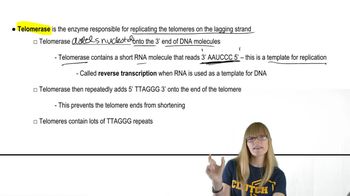DNA replication synthesizes DNA in which direction?
Table of contents
- 1. Introduction to Genetics51m
- 2. Mendel's Laws of Inheritance3h 37m
- 3. Extensions to Mendelian Inheritance2h 41m
- 4. Genetic Mapping and Linkage2h 28m
- 5. Genetics of Bacteria and Viruses1h 21m
- 6. Chromosomal Variation1h 48m
- 7. DNA and Chromosome Structure56m
- 8. DNA Replication1h 10m
- 9. Mitosis and Meiosis1h 34m
- 10. Transcription1h 0m
- 11. Translation58m
- 12. Gene Regulation in Prokaryotes1h 19m
- 13. Gene Regulation in Eukaryotes44m
- 14. Genetic Control of Development44m
- 15. Genomes and Genomics1h 50m
- 16. Transposable Elements47m
- 17. Mutation, Repair, and Recombination1h 6m
- 18. Molecular Genetic Tools19m
- 19. Cancer Genetics29m
- 20. Quantitative Genetics1h 26m
- 21. Population Genetics50m
- 22. Evolutionary Genetics29m
8. DNA Replication
Overview of DNA Replication
Problem 1e
Textbook Question
In the discussion, we focused on how DNA is replicated and synthesized. We also discussed recombination at the DNA level. Along the way, we encountered many opportunities to consider how this information was acquired. On the basis of these discussions, what answers would you propose to the following fundamental questions?
What observations reveal that a 'telomere problem' exists during eukaryotic DNA replication, and how did we learn of the solution to this problem?
 Verified step by step guidance
Verified step by step guidance1
Understand the 'telomere problem': During eukaryotic DNA replication, the lagging strand synthesis cannot fully replicate the ends of linear chromosomes due to the requirement for a primer and the inability of DNA polymerase to synthesize DNA in the 3' to 5' direction. This results in progressive shortening of telomeres with each cell division.
Recognize the observations that revealed the problem: Scientists observed that telomeres, the repetitive DNA sequences at the ends of chromosomes, become shorter in cells that divide repeatedly. This shortening was linked to cellular aging and eventual senescence.
Learn about the discovery of telomerase: Researchers identified an enzyme called telomerase, which adds repetitive nucleotide sequences to the ends of telomeres, counteracting the shortening. Telomerase contains an RNA template that guides the addition of telomeric repeats.
Understand the mechanism of telomerase: Telomerase extends the 3' overhang of the telomere, allowing the lagging strand synthesis machinery to complete replication of the chromosome ends. This prevents the loss of genetic information during replication.
Explore experimental evidence: Experiments with telomerase-deficient cells showed accelerated telomere shortening and premature cellular aging, while cells with active telomerase maintained telomere length and extended their replicative lifespan. This confirmed the role of telomerase in solving the 'telomere problem'.
 Verified video answer for a similar problem:
Verified video answer for a similar problem:This video solution was recommended by our tutors as helpful for the problem above
Video duration:
2mPlay a video:
Was this helpful?
Key Concepts
Here are the essential concepts you must grasp in order to answer the question correctly.
Telomeres
Telomeres are repetitive nucleotide sequences located at the ends of eukaryotic chromosomes, protecting them from degradation and preventing the loss of essential genetic information during DNA replication. As cells divide, telomeres shorten, which can lead to cellular aging and limit the number of times a cell can divide, a phenomenon known as the Hayflick limit.
Recommended video:
Guided course

Telomeres and Telomerase
DNA Replication
DNA replication is the biological process by which a cell duplicates its DNA before cell division. This process involves unwinding the double helix and synthesizing new strands using existing strands as templates. However, the mechanism of replication cannot fully replicate the ends of linear chromosomes, leading to the 'telomere problem' where important genetic information could be lost.
Recommended video:
Guided course

Steps to DNA Replication
Telomerase
Telomerase is an enzyme that adds repetitive nucleotide sequences to the ends of telomeres, counteracting their shortening during DNA replication. It is particularly active in stem cells and cancer cells, allowing them to maintain telomere length and continue dividing. The discovery of telomerase provided insights into how cells can overcome the limitations imposed by telomere shortening.
Recommended video:
Guided course

Telomeres and Telomerase
Related Videos
Related Practice
Multiple Choice
842
views
2
rank


